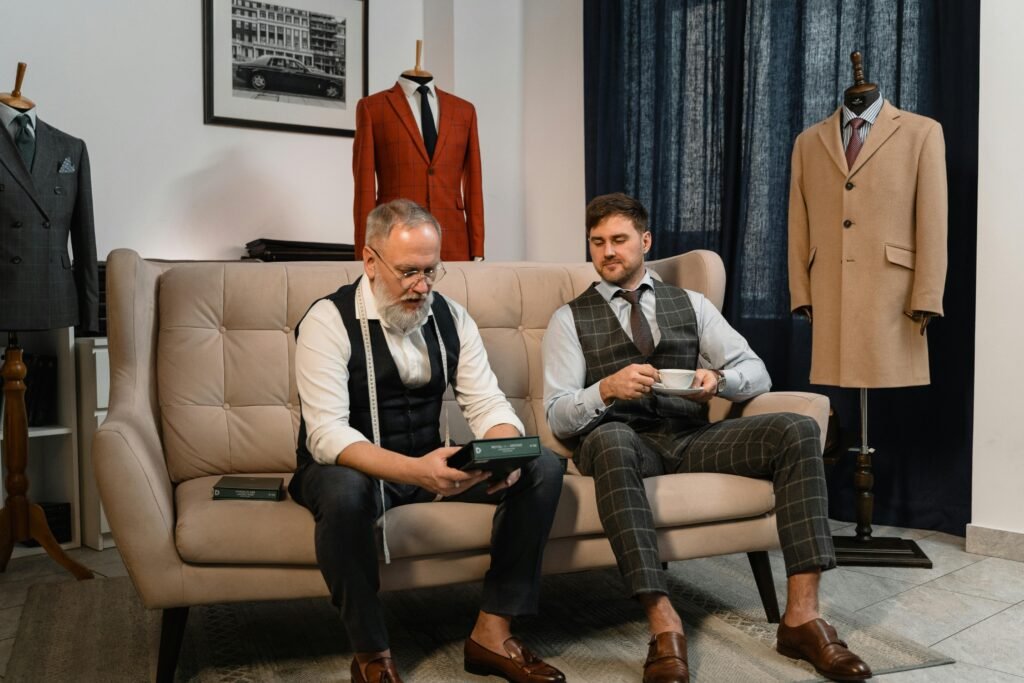Finding high-quality clothing can be like trying to find a needle in a haystack in a world where fast fashion rules the market. On the other hand, spending money on well-made clothing not only improves your style but also makes sure your wardrobe lasts. Everything you need to know about fine clothes, including fabric options, construction specifics, and how to take care of your items, will be covered in this.

1. Understanding Fabrics
The fabric is the cornerstone of each fine clothing item. Natural fibers are frequently more pleasant and long-lasting than synthetic substitutes, such as cotton, wool, silk, and linen. Here’s a little explanation:
Cotton: To get long-staple cotton that is noted for its strength and suppleness, look for Egyptian or Pima cotton. Over time, these cotton varieties hold up better and don’t pill.
Wool: Merino or cashmere wool is of superior quality and provides exceptional softness and insulation. Tight weave is important since loose weaves might wear out faster.
Silk: Mulberry silk is the best; it has a gorgeous luster and a plush feel. The texture and color of silk of superior grade will be uniform.
Linen: This airy material is ideal for warm climates. Superior quality linen gets softer with every wash and has a lovely sheen.
Pro Tip: Make sure the label indicates the type of cloth used. If you want long-lasting quality, stay away from mixes with large synthetic fiber percentages.

2. Inspecting the Construction
An important determinant of a garment’s quality is its structure. Observe the following:
Seams: Well-made garments will have seamless, uniform seams free of loose threads. There shouldn’t be any puckering along the seams; the stitching should be firm and uniform.
Hems: Well-made clothing has completed hems with a concealed seam or double stitching. This increases durability and reduces fraying.
Lining: An item of clothing with all the lining looks nicer and lasts longer. There should be no wrinkling or tugging, and the lining should be smooth and firmly bonded.
Buttons and Zippers: Verify that the buttons are firmly secured and that the buttonholes are sewn nicely. There should be no gaps between the zippers and they should slide in easily.
Pro Tip: Turn the garment inside out to inspect the construction. Quality is often most evident on the interior where shortcuts can’t be hidden.
3. Fit and Tailoring
If the clothing is poorly fitting, even the most costly item will not look decent. Although better clothing is sometimes made with a more personalized fit, you could still need to make adjustments to get the ideal appearance. Here’s how to determine if they fit:
Shoulders: The seams ought to line up with your shoulders’ edges. The fit is incorrect if they are too in or out.
Length of Pants and Sleeves: Pants should end at the top of your shoes, and sleeves should strike right at the wrist bone. Should it be longer or shorter, adjustments will be necessary.
Waist and Torso: The clothing should fit your body shape without being overly restrictive. The hips, back, or chest shouldn’t be pulled across.
Pro Tip: Never be reluctant to get your clothes tailored. A few little alterations may significantly alter the fit and appearance of a garment.
4. Evaluating Durability
High-quality apparel is distinguished by its durability. If you want to make sure your purchase can withstand frequent wear, look for these signs:
Weight of Fabric: Sturdier textiles tend to weigh more. A thicker fabric usually denotes superior quality, however this isn’t necessarily the case with summer apparel such as jackets, pants, and sweaters.
Adaptability: Take a look at the “scrunch test” by crumpling a tiny piece of cloth in your palm for a short while. It’s a measure of resilience if it bounces back without wrinkling too much.
Information: Keep an eye out for little features like additional fabric in hems and seams, bar tacks at stress places, and reinforced buttons. These components strengthen an article of clothing as a whole.
5. Caring for High-Quality Clothing
To keep your fine apparel looking as good as new for as long as possible, proper maintenance is required. Here are some tips to ensure that your clothes last a long time:
Washing: Make sure you always follow the label’s care recommendations. Avert strong chemicals and use mild detergents. Wool and silk are examples of delicate materials that are best washed by hand or on a cold, gentle cycle.
Drying: Since heat damages materials, air drying is preferable for the majority of clothing. To preserve the form of knits in particular, lay them flat to dry.
Storage: Keep clothes somewhere dry and cold. To avoid stretching heavier clothing, such as sweaters, fold them and use cushioned hangers for delicate goods. To keep precious pieces safe from dust and moths, think about using garment bags.
Pro Tip: To prevent wearing your best pieces too often, rotate your wardrobe. By doing this, the wear and tear on your clothes is distributed more fairly.
6. Where to Shop for High-Quality Clothing
Finding high-quality clothing requires knowing where to shop. Here are some tips:
Established Brands: Look for brands with a long history of quality craftsmanship. These brands often have stringent quality control processes and a reputation to uphold.
Boutiques and Independent Designers: Smaller shops and independent designers may offer unique, well-made pieces that aren’t mass-produced. These can be great finds for those looking for something special.
Second-Hand and Vintage: Don’t overlook thrift stores and vintage shops. High-quality clothing often outlasts trends, so you can find timeless pieces that are still in great condition.
Pro Tip: Be cautious with online shopping. Read reviews, check return policies, and if possible, order from sites with easy returns in case the quality isn’t as expected.
7. Investing in Timeless Pieces
Finally, when building a wardrobe of high-quality clothing, focus on timeless pieces that won’t go out of style. Classic items like a well-tailored blazer, a little black dress, a quality pair of jeans, and a cashmere sweater can be worn for years and adapted to various trends.
Pro Tip: Spend more on items you’ll wear often and less on trendy pieces that might only last a season. This approach ensures that your wardrobe remains versatile and durable.

Conclusion
Purchasing premium apparel is about more than simply looking good—it’s about making decisions that promote longevity, sustainability, and style. You may create a wardrobe that looks beautiful and lasts a long time by learning about textiles, construction, fit, and maintenance. Keep in mind that the secret to a wardrobe that will last you for years is to choose quality over quantity.


